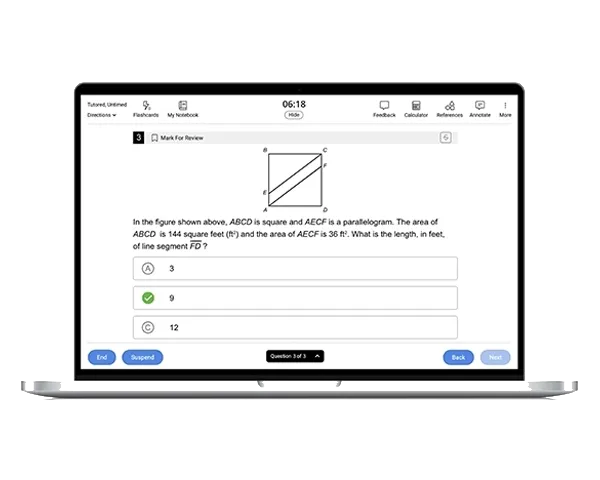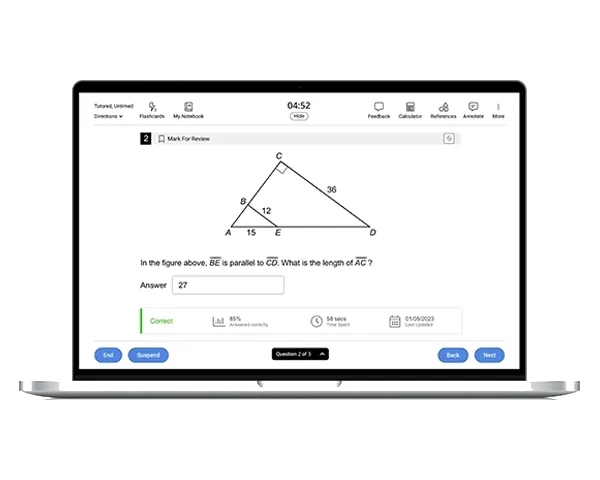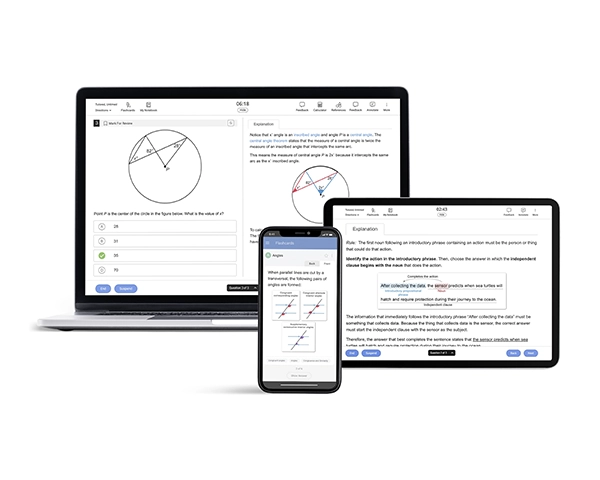The SAT® Math section covers content from Algebra, Problem-Solving and Data Analysis, Advanced Math, Geometry, and Trigonometry. Even if you are confident in all these tested subject areas, you should familiarize yourself with the format and timing of the exam if you hope to receive a high score.
Planning Your Digital SAT Math Prep
You’ll need strong fundamentals in algebra, advanced math, data analysis, and geometry to do well on SAT Math. But mastering content alone isn’t enough—you also need a smart, structured study plan. Start by asking yourself these 5 key questions to shape your math prep:

Setting Goals for SAT Math
Universities and the College Board® do not deem any SAT score as "passing" since the exam is graded on a 1600 scale. Check the score range most commonly accepted by your dream school to determine your target score.
If your diagnostic test score is far from that target, you likely need to fill in some content gaps. Group the questions you answered correctly and incorrectly from your practice test into categories based on the 4 official SAT math domains: Algebra, Problem-Solving and Data Analysis, Advanced Math, and Geometry and Trigonometry. Our performance dashboard automatically does this for you.
When to Start Preparing
High performance in the SAT Math section requires familiarity with the content, the exam format, and how to tackle both under pressure. Begin at least 3-6 months ahead of your test date. This gives you enough time to build confidence with the content, identify weak areas, and adjust to the new digital format.
Ideal Session Length for Math Prep
Keep your sessions short but consistent — 20 to 30 minutes, 2-3 times a week. Focus on concept reviews, question practice, and explanation analysis. Don’t forget to take a timed practice test at the start, halfway point, and 1-2 weeks before test day.
How To Do Well on the SAT Math Section
Success in the SAT Math section is about more than just knowing formulas — it’s about applying your knowledge efficiently under timed, digital conditions. If you're aiming for a perfect score, you'll need to pair that foundational understanding with high-level strategy, precision, and consistent practice. Here's how to get 800 on SAT Math:
Effective Strategies for High Math Scores
- Understand Core Concepts: Prioritize mastery of linear equations, quadratic functions, systems, ratios, percentages, and statistics.
- Practice with Purpose: Use high-quality questions with step-by-step explanations. Don’t just guess — learn from every mistake.
- Analyze Your Mistakes: Identify why you missed each question and note the concept or strategy involved.
- Simulate Test Conditions: Take full-length SAT tests to build pacing and stamina.
- Work on One Topic at a Time: Strengthen your algebra before moving on to advanced math, data analysis, or geometry.
Most Challenging Topics in SAT Math
- Quadratic functions and systems of equations
- Function notation and transformations
- Scatterplots, tables, and trendline analysis
- Geometric applications like angles, circles, and area problems
Focus on mastering these topics, especially if they caused confusion in your diagnostic test.
How to Self-Study for SAT Math
Studying on your own? An SAT Math independent study plan can be highly effective when approached with structure and consistency. Here’s how to stay on track:
- Use trusted tools like UWorld’s SAT Math QBank.
- Study 2-3 times per week in 20-30 minute blocks.
- Use digital flashcards and performance analytics to target weak spots.
Like the SAT, the SAT Math section covers content from Pre-Algebra through Geometry, Algebra II, and Pre-Calculus, which means you'll need to recall specific concepts from multiple classes. Chances are, you took these classes over a few years, and you already learned how to solve these problems, so you need to refresh your memory on how to solve these problems and practice answering them in under a minute. Enter SAT Math independent study.

SAT Math Exam Study Tips
Regardless of how far in advance you can study, make the most of your time by following the tips below.
Take High-Quality Practice Tests
The best way to ensure you're ready to get the score you need is to earn that score on a SAT practice test.
While the College Board offers a few practice tests, taking one every few weeks during your study plan is
essential. Invest in a quality SAT prep course
like UWorld that lets you generate an unlimited amount of SAT math practice tests and includes a study guide with comprehensive explanations
to help you immediately fill in the conceptual gaps identified by the diagnostic.
Underline Key Parts of the Question
Marking values, equations, and the final task helps minimize careless errors. For example, don’t solve for x if the question asks for x + 3.
Be Aware of Timing
Each math question should take just over a minute. Review solution strategies or try a different approach if you're consistently over that.
Eliminate 3 Wrong Answers
Use the process of elimination by checking which choices are out of range or logically incorrect. Elimination helps you avoid traps and reinforces reasoning.
Know Your Calculator Rules
Ensure your calculator is SAT-approved and in working order. While the digital SAT offers a built-in DESMOS calculator, you can use your own. Check out the approved calculators list on our SAT Test Policies page. Remember that you might be banned from using your own calculator if you carry a calculator not approved by the College Board.
Translate Words Into Math
Turn verbal questions into equations. For example, model a discount problem using percentages or set up algebraic equations for profit/loss.
Use and Label Diagrams
Label all figures, even if you draw them. This helps you track values and reveals relationships you might otherwise overlook.
Learn Mental Math Tricks
Mental math can speed you up significantly. To save calculator time, practice estimating square roots, simplifying fractions, and spotting percent conversions.
SAT Math Study Plan
A well-organized preparation strategy adapted to your specific timeline – be it 3 months or 6 months – can significantly improve your results. Let's look at how to structure your preparation based on the time you have.
SAT Math Study Materials
Besides diagnostic tests, the most important resource for your math preparation is an abundance of SAT-like math questions paired with comprehensive, easy-to-follow answer explanations. As you shop for study materials, prioritize those with a heavier emphasis on practice questions (those whose questions look and feel like real SAT questions). For example, UWorld's SAT QBank is modeled to mirror the format and key concepts tested by the SAT, plus it comes with illustrated, step-by-step breakdowns of each answer that teach not only that question's solution but also strategies for approaching similar questions on exam day.

References
- The Math Section (n.d.). satsuite.collegeboard.org. Retrieved April 14, 2025 from
https://satsuite.collegeboard.org/sat/whats-on-the-test/math - SAT Calculator Use. (n.d.). satsuite.collegeboard.org. Retrieved April 14, 2025 from
https://satsuite.collegeboard.org/sat/whats-on-the-test/math/calculator-use.

